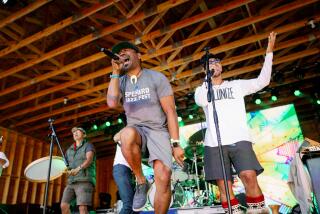Montreal: Center for Eskimo Art
- Share via
Few Eskimos live in Montreal. Nevertheless, this charming and sophisticated capital of French-Canadian culture is a center for Eskimo art. Some exceptional galleries and shops are showing and selling sculptures, carvings, prints and handicrafts produced by Eskimos in their settlements and towns far to the north inside the Arctic Circle.
The largest Eskimo population is in Arctic Canada. They are racially related to the American Indians, but their customs and language are different.
The name Eskimo, given to them by the American Indians, means eater of raw fish. They refer to themselves as Inuit, a word that in their language means first people or real people. During the 1970s, the Canadian government passed a law that this population should be officially referred to as Inuit.
Some tourists would hesitate to venture into the remote and climatically inhospitable areas inhabited by the Inuit. The communities are small, isolated, inaccessible, in the middle of the tundra, where winter temperatures fall to 100 degrees below zero.
Most Inuit have clustered into settlements with 100 to several hundred inhabitants, among whom are usually a small minority of non-Inuit people.
Contact With Foreigners
Regular contact with foreigners began in the early 1900s, but it was not until the 1950s that a nomadic way of life, in which the Inuit relied on hunting and fishing for survival, gradually gave way to more permanent settlements.
The process of cultural assimilation has been rapid. Snowmobiles have replaced traditional dog sleds, igloos and sealskin tents are being exchanged for wooden huts and guns are used more frequently than harpoons. Inuit life is changing rapidly. It is in the art that traditions are commemorated and kept alive.
About 45 Inuit communities in Arctic Canada produce artwork that is distributed throughout Canada by Inuit cooperatives. Montreal galleries have extensive collections, and some of the biggest choices of work from all the communities, including the most famous Cape Dorset, Pangnirtung, Baker Lake, Pelly Bay, Frobischer Bay, Repulse Bay and others.
Art has become a major source of income for the Inuit. In 1980 it generated more than $5 million. Most of the art is made for the foreign market but it is one aspect of Inuit life that preserves the old ways. The traditional materials and methods are still used, and each part of the process is done entirely by hand.
The sculptor goes out to dig up the gray soapstone or green serpentine or to hunt for ivory, antler or bone. Hunting for whale is restricted and most whalebone sculptures are made with the bones of whales long dead, whose remains are found in remote areas along the Arctic coasts.
Loons and eider ducks are hunted and their skins sewn into tapestries. Caribou horns are engraved with scrimshaw, a technique developed by the Inuit more than 1,000 years ago, although until recently it was assumed that the technique had been taught to them by European traders.
Myths and Sociology
The art portrays the traditional ways of doing things as well as the myths and sociology of the Inuit. One of the most popular themes is the hunt, which, before the introduction of preserved food, meant survival.
One sees statues of men in pursuit of bears or seals. The hunters’ spears are raised for the kill, and the pieces are filled with kinetic tension. There are men fishing through the ice. The fishing lines are wound around their wrists, and you can almost feel their stillness as they wait for a bite.
Myths are also popular subject matter. Sedna, the half-woman, half-fish who is believed to control the sea and living creatures, frequently appears in soapstone or bone. Her frolicking attitude and happy expression doesn’t fully tell her complex and sad story of cruel love and fatherly betrayal. She is a charming figure and a favorite of many of the better-known Inuit sculptors.
Religious beliefs are also expressed in portraits of animals with human features. It is commonly believed that medicine men with magic powers can transform themselves into animal spirits and that animals can be transformed into other animals. The bear, seal, musk ox, dog and other animals often appear in their own forms. And there are frequent portrayals of mother and child and tableaux of family life.
Printmaking is the most popular form of art. It was introduced in 1950 in Cape Dorset. The Inuit have major printmaking workshops in Cape Dorset, Holman, Baker Lake, Pangnirtung and Povungnituk. Each workshop has a slightly different style, using similar techniques of stone cut/stencil.
In general, stone cuts produce rougher-edged shapes than stencils. The soft soapstone at Cape Dorset allows for textural patterning and production of complex images. Pangnirtung has hard soapstone that permits fine detailing in rendering fur and skin; hard soapstone will print up to 50 copies.
An Enchanting Art
In Povungnituk, artists beautifully combine stencil and stone cut. Baker Lake is known for its complex linear designs. All of the print shops use exquisite coloration, always applied manually. And the themes of the prints are similar to those of the sculptures.
Inuit art provides a way to learn about a people with a sophisticated culture, a fascinating history and a refreshingly egalitarian outlook on life. In Montreal, galleries and shops have books, brochures and other background material that will help you.
Begin at the Montreal Museum of Fine Arts, 3400 Museum Ave., phone (514) 285-1600, where you’ll discover an exhibition of Inuit sculptures and prints as well as a shop with works from the major communities. The selection is limited but the pieces are carefully selected and expensive. If you’re looking for a gift item, the museum shop carries a Inuit silk scarf in four traditional scenes. They cost $35-$45.
The Canadian Guild of Crafts Quebec, 2025 Peel St., phone (514) 849-6091, is a nonprofit organization with a large exhibition of pieces from the 1950s to ‘60s. It also has Inuit prints for $15 and up.
Inuit sculptures vary in price, from about $50 and up, depending upon the size, age, detailing and, most importantly, the artist. The Canadian Guild of Crafts has a lot of information about Inuit art, and the staff is helpful. Its catalogue is a valuable reference source. It also sells handicrafts by American Indians and other Canadian artisans.
Galerie Elca London, 1616 Sherbrooke W., phone (514) 931-3646, is a private gallery that shows the work of contemporary Canadian artists. The owners have a true love and deep respect for Inuit art, and the collection is superb. Much of it is kept in the gallery storerooms and offices. Ask to see it. You’ll be treated to some unusual pieces, some old pieces. A carved soapstone bear (about six inches tall) from Pangnirtung costs about $65. Tommy Kunilusie is a well-known sculptor from Clyde River; his soapstone walrus with nylon whiskers costs about $100. A caribou bone dancer with a drum, by Sobrina from Pelly Bay, is about $115. A sizable serpentine sculpture of an exhausted woman, sagging under the weight of the child she’s carrying on her back, by Youtie Soudloo of Lake Harbour, costs $465.
Other Locations
Le Rouet, 700 St. Catherine St. W., phone (514) 861-8401, and other locations in Montreal and through Canada offer a sampling of Canadian crafts, with Inuit sculpture, prints and clothing well represented. Inuit scrimshaw of huskies and other animals sells for $50 and up. A large hunt scene is $165. Inuit prints and carvings are reasonably priced. And mukluks (Inuit moccasin boots) are $20. All are handmade.
The Canadian government has a seal of authenticity for Inuit carvings: an igloo in a rectangle. You won’t find it on all pieces, but its presence can dispel doubts.
Before buying anything made of whalebone, remember it is on the U.S. Customs restricted list.
Prices quoted reflect currency exchange rates at the time of writing.
More to Read
Sign up for Essential California
The most important California stories and recommendations in your inbox every morning.
You may occasionally receive promotional content from the Los Angeles Times.










